Insect collecting
Insect collecting refers to the collection of insects and other arthropods for scientific study or as a hobby. Because most insects are small and the majority cannot be identified without the examination of minute morphological characters, entomologists often make and maintain insect collections. Very large collections are conserved in natural history museums or universities where they are maintained and studied by specialists. Many college courses require students to form small collections. There are also amateur entomologists and collectors who keep collections.
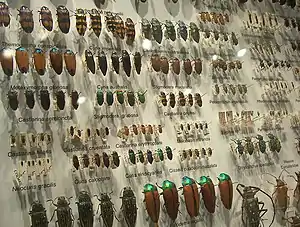
Historically, insect collecting has been widespread and was in the Victorian age a very popular educational hobby. Insect collecting has left traces in European cultural history, literature and songs (e.g., Georges Brassens's La chasse aux papillons (The Hunt for Butterflies)). The practice is particularly common among Japanese youths.
Collecting techniques

Insects are passively caught using funnels, pitfall traps, bottle traps, malaise traps, flight interception traps and other passive types of insect traps, some of which are baited with small bits of sweet foods (such as honey). Different designs of ultraviolet light traps such as the Robinson trap are also used by entomologists for collecting nocturnal insects (especially moths) during faunistic survey studies. Aspirators or "pooters" suck up insects too small or delicate to handle with fingers.[1]
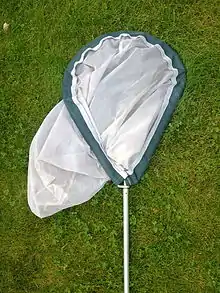
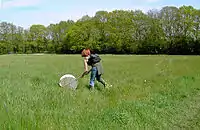
Several different types of nets are commonly used to actively collect insects. Aerial insect nets are used to collect flying insects. The bag of a butterfly net is generally constructed from a lightweight mesh to minimize damage to delicate butterfly wings. A sweep net is used to collect insects from grass and brush. It is similar to a butterfly net, except that the bag is generally constructed from more rugged material. The sweep net is swept back and forth through vegetation quickly turning the opening from side to side and following a shallow figure eight pattern. The collector walks forward while sweeping, and the net is moved through plants and grasses with force. This requires a heavy net fabric such as sailcloth to prevent tearing, although light nets can be used if swept less vigorously. Sweeping continues for some distance and then the net is flipped over, with the bag hanging over the rim, trapping the insects until they can be removed with a pooter. Other types of nets used for collecting insects include beating nets and aquatic nets.[2] Leaf litter sieves are used by coleopterists and to collect larvae.
Once collected, a killing jar is used to kill required insects before they damage themselves trying to escape. However, killing jars are generally only used on hard-bodied insects. Soft-bodied insects, such as those in the larval stage, are generally fixed in a vial containing an ethanol and water solution.[3] Another now mostly historical approach is Caterpillar inflation where the innards were removed and the skin dried.[4]
Storage and curation
.jpg.webp)
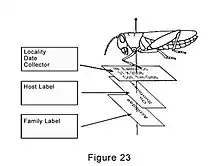
There are several different preservation methods that are used; some of which include: dried preservation (pinning), liquid preservation, slide mounts, other various preservation methods. Dried preservation is by far the most common form of insect preservation. The large majority of the time insects are pinned vertically through their mesothorax and slightly off-center to the right of the mid-line.[5] It is better to pin a insect that has died recently enough that they have not dried yet because it allows the thoracic muscles to adhere to the pin (previously dried specimens must have glue applied to the pin location to avoid spinning). the pin should sit with 1/4 of the pin above the insect as to allow enough room for labels to be readable underneath. When pinning insects with wings for display it is important to display them properly: Lepidoptera wings should always be spread. Orthopteroids often have left wings spread. In scientific collections it is often found that the insect's wings, legs, and antenna are tucked underneath it to conserve space. When pin-mounting small insects the insect is glued to a piece of non acidic, triangle paper. This is called pointing. When drying an insect the relaxed insect is spread out accordingly using pins on a foam block where it can dry and retain its positioning. When drying insects with wings such as butterflies setting paper is used to position the wings. When labeling insects the labels are presented in this order top down: Locality, additional locality/voucher label/accession numbers, insect identification.[6]
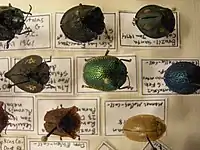
Rare insects, or those from distant parts of the world, may also be acquired from dealers or by trading. Some noted insect collections have been sold at auction.[7]
In popular culture
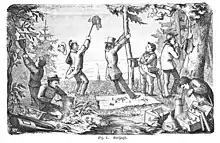
Pokémon creator Satoshi Tajiri's childhood hobby of insect collecting is the inspiration behind the popular video game series.[8]
A beetle collection becomes a source of fascination for a mentally disturbed woman in Chapter XI of MacKinlay Kantor's Pulitzer Prize-winning novel "Andersonville" (1955).
See also
References
- Martin, J.E.H. 1977. Collecting, preparing and preserving insects, mites, and spiders. The Insects and Arachnids of Canada, Part 1. Publ. 1643, Res. Br., Canada Dep. Agric., Ottawa, ON. Archived PDF
- Charles Valentine Riley, 1892 Directions for collecting and preserving insects Bulletin (United States National Museum) no. 39, pt. F. Washington,Govt. Printing Off. Full text online here
- Hongfu, Zhu, 1949 How to know the immature insects; an illustrated key for identifying the orders and families of many of the immature insects with suggestions for collecting, rearing and studying them, by H. F. Chu. Pictured key nature series Dubuque, Iowa,W. C. Brown Co.Full text online here
- Gibb, Timothy J; Oseto, Christian (2006). Arthropod Collection and Identification: Laboratory and Field Techniques. Academic Press. p. 67. ISBN 0123695457.
- Department of Entomology. "How to Make an Awesome Insect Collection: Purdue: entomology: insect: collect: supplies: specimen: mounting: identifying: displaying: preserve: labels". Purdue. Retrieved December 27, 2019.
- V.M. Uys & R.P. Urban (Eds.): "How to Collect and Preserve Insects and Arachnids". Pretoria 2006. 112 p. ISBN 1-86849-311-3
- "A rich and diverse fauna : the history of the Australian National Insect Collection; 1926–1991". Melbourne : CSIRO, 1997. 386 p. ISBN 0-643-06322-6
- Pokémon inspired from creator’s bug collection hobby, inshorts
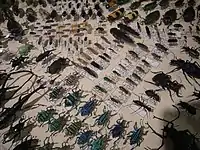
Further reading
Picture Guide series For college students. Out of date but very useful for beginners.
- Harry Edwin Jaques, 1941 How to know the insects; an illustrated key to the more common families of insects, with suggestions for collecting, mounting and studying them. His Pictured-key nature series Mt. Pleasant, Ia.,The author Full text online here Excellent college level guide
- Hongfu, Zhu, 1949 How to know the immature insects; an illustrated key for identifying the orders and families of many of the immature insects with suggestions for collecting, rearing and studying them, by H. F. Chu. Pictured key nature series Dubuque, Iowa,W. C. Brown Co.Full text online here
External links
| Wikimedia Commons has media related to Insect collecting. |
| Wikimedia Commons has media related to Insect Collections Methodology. |
- Capture methods and techniques Intermediate level
- Collecting and Preserving Insects and Mites: Tools and Techniques; PDF Comprehensive, detailed download. Advanced level.
- How to make an insect collection; containing suggestions and hints designed to aid the beginning and less advanced collector (Wards Natural Science Establishment 1945)
- How to collect and preserve insects (H. H. Ross) Full text of 1962 printing
- Expedition Insect Manual PDF
- Chris Raper Insect Collecting Easy to read Excellent illustrations]
- Insect Collection Manual Australian Museum introductory guide.Beginner level
- Curation Of Insect Specimens N P S Beginner level
- Museum handbook
- Garthe's Insect Gradebook Butterfly mounting.
- Coke Smith Insect Collection
- A.Tereshkin Devices for Ichneumonidae collecting.Advanced
- Why We Kill Bugs- The Case for Collecting Insects Rationale for insect collecting
